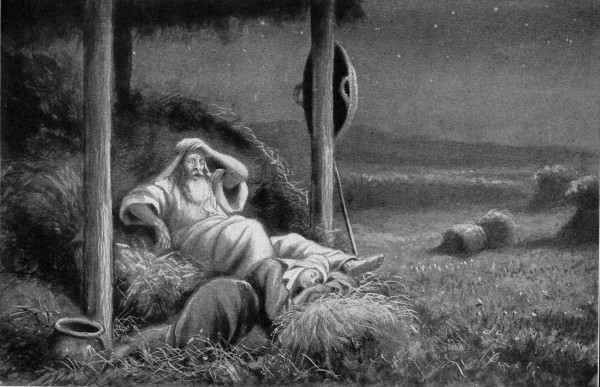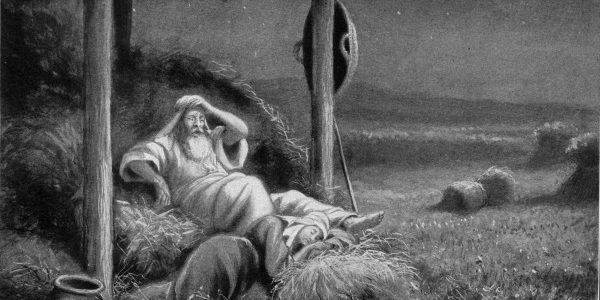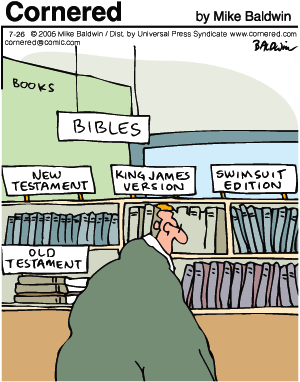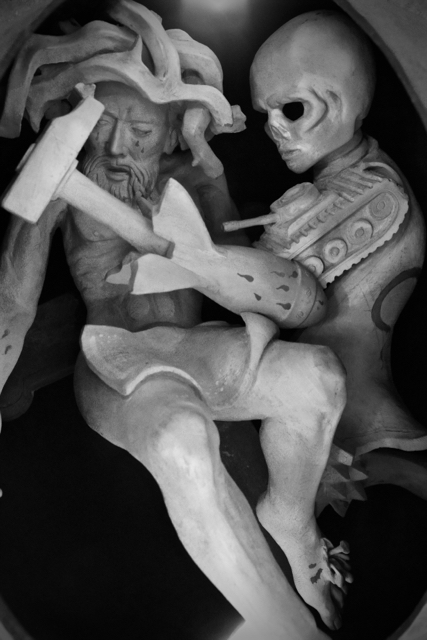I just finished this section and I thought it curious (bizarre, amusing) enough to share this snippet. This is from my commentary on Tg. Ruth. No footnotes are reproduced.

The Targumist follows the beginning of verse 8 very closely until he reaches the point where Boaz “was startled and turned over” וַיֶּחֱרַד הָאִישׁ וַיִּלָּפֵת. The Targumist has included what at first glance may seem to be simply a Midrashic addition with little connection to the base text, but in reality is closely connected: “…and he trembled, his flesh became soft like a turnip from fear,” ורתת ואיתרכיך בישׂריה כליפתא מן רתיתא. First, the Hebrew וַיֶּחֱרַד, “he was startled” is from the root *חרד and can mean “tremble” or “to be afraid” is rendered with ורתת, “he trembled.” The Targumist then renders וַיִּלָּפֵת, “he turned over” with ליפתא, “turnip,” since both words share the same consonants and the phrase fits the context. Finally, the Targumist says that his flesh became soft “like a turnip from fear.” This latter phrase מן רתיתא can also be viewed as a rendering of mt’s וַיֶּחֱרַד. Each element of this extended and vivid description of Boaz’s response has some connection with the underlying Hebrew text.
The same word-play found in b San. 19b, but with quite the opposite meaning.
“The strong desire affecting Joseph was modest for Boaz, in line with that which is written, ‘And it came to pass at midnight, and the man was startled’ (Ruth 3:8).” What is the meaning of “was startled” [וילפת] ? Said Rab, “His penis became as hard as a turnip top.”
Rab clearly has in mind an uncooked turnip. The Targum, on the other hand, clearly states that it was “softened.” So the Targumist envisions what in modern English colloquialism might be referred to as “goose bumps,” “goose pimples,” or “goose flesh,” where the skin develops small bumps either from cold, fear, or arousal.
Melamed and Churgin both see Tg. Ruth as reliant upon the Talmudic source. Beattie rejects that suggestion and I am inclined to agree with him. Both readings play on the same fact, the sharing of consonants between these two terms. There seems no clear reason to view the Talmud as the origin of this interpretation. In fact, one could equally make the opposite argument, that Tg. Ruth is in fact the origin of this exegetical tradition. The Targumist’s use of a “soft” turnip matches the context visualized by the biblical author: the man awakes in the cool of the night and is startled and afraid. All of that fits the situation in which one might experience “goose bumps.” On the other hand, Rab’s interpretation requires that Boaz was already aware that Ruth was there and had time to be aroused to the state of a “turnip top.” It doesn’t seem to fit as well with the biblical context as does the Targumic version. Of course fitting in that context is less of a concern for general Midrashic interpretation, but is usually a consideration in Targumic renderings. That being said, there are no criteria that can be used to definitively prioritize one tradition over the other. The Talmud does, however, also contain additional exegetical elements shared with the Targum.
The Targumist, for his part, is not unaware of the sexual tension in this scene and decides to heighten the situation. Once he has seen the woman (וחמא והא איתתא) Boaz does begin to react.
His desire grew strong, but he did not approach her, just as did Joseph the Righteous who refused to approach the Egyptian woman, the wife of his master; just as Paltiel bar Laish the Pious did, who placed a sword between himself and Michal daughter of Saul, wife of David, whom he refused to approach.
We noted earlier that this scene is sexually charged and ambiguous, so it should not come as a surprise that the Targum sought to clarify the ambiguity and to do so in such a way that removed all doubt as to the chastity of both Boaz and Ruth. I would be remiss if I did not comment on the manner in which the Targumist does this, but first a textual note.
Valmadonna is alone in rendering the phrase which opens this section with ותקף יצריה, “his desire grew strong.” All other English translations read something like “he restrained his desire.” These scholars are all following the other mss which have וכבש. I have followed V since it is the oldest textual witness and it also provides a reasonable reading. It works to the Targumist’s agenda to show that Boaz had great desire for her and yet still was able to “refuse to approach her.” His piety is all that much more to be admired.
Indeed, the Targumist could well have considered a rendering that would remove all ambiguity and sexual overtones, simply stating that there was no sexual contact, perhaps even stopping after the addition of “his desire grew strong, but did not approach her.” Yet the Targumist goes beyond and compares Boaz’s stoic behavior to that of Joseph and Paltiel. This exegetical tradition is also found in b. Shab. 19b and 20a and is the larger context for the discussion of Boaz’s “turnip.” The story of Joseph is well known, as he rejected the advances of Potiphar’s wife (Gen 39:7-13). The reference to “Paltiel bar Laish,” is a reference to 1 Sam. 25:44 and 2 Sam. 3:15 and is slightly less well known. Palti was given David’s wife (and Saul’s daughter) Michal as his wife when David had to flee from Saul (1 Sam 25:44). Eventually David receives her back (2 Sam 315), but in this passage he is referred to as “Paltiel.”
Said R. Yohanan, “He was really called Palti, and why was he later called Paltiel? Because God (el) saved him from transgression [namely, marrying an already-married woman].
“What did [God] do? He put a sword between him and her [so they did not have sexual relations], saying, ‘Whoever gets involved in this matter will be pierced by this sword.’”
By drawing comparison with these two figures who resisted sexual temptation the Targumist further develops the character of Boaz as a pillar of piety and places him within the company of other chaste heroes. Whereas I argued earlier that there is no way to determine whether or not the Talmud or the Targum was the origin of the tradition regarding Boaz’s “turnips,” in this case the Targum is clearly dependent upon preexisting exegetical tradition. The reference to Joseph is self-explanatory and evident within the biblical text itself, the same cannot be said about the references to Paltiel. The traditions ascribing such piety to him are all later and extra-biblical. The Targumist’s audience would have to be aware of that tradition in order to understand the reference to Paltiel and his sword.





4 thoughts on “Boaz’s Turnips – Or Boaz Wakes Up By a Pile of Barley”
This is fantastic, although there is one detail regarding which I am confused. I have always read this scene to imply (thanks to Rendsburg), sure they had sexual relations. So what? Not because extramarital relations are no big deal (clearly they are in the Hebrew Bible! we have talked about this) but simply because that is how levirite marriage works (see Mishnah). Several years ago an Old Testament scholar suggested Ruth wanted Boaz to think they had sexual relations… but maybe/probably they did not. So Boaz wakes up and wonders, Oh man what happened while I was drunk??? Although we both know that if a man has had sexual relations… he (ahem) will know. So apparently the Targum is at pains to emphasize no no no, they did *not* have sexual relations. Which raises questions about why exactly the Targumist would have regarded that as a blemish on Boaz’s piety.
What confuses me is the “flesh became soft” bit. I can understand he wakes up with an erection (which… might not have much to do with a woman at his “feet”… that’s what happens to men when they sleep). I still don’t quite get how his flesh can be hard like a turnip (erection) and yet soft like a turnip.
Rick, thank you for your comments! A few thoughts in reply.
First, I do not think the text says they had sexual relations. “Imply” of course, the whole point is to tittilate the audience, but I do not think it suggest that they consummated. After all, if they had the rest of the story would be unnecessary. Once they had had coitus Ruth was no longer fit for “So and So” and their relationship would have been sealed. (FWIW I remember Rendsburg saying that it was designed to engage the audience with all the double entendre, but I do not recall him saying that they actually had sex.)
Second, levirate marriage is a complicated affair with respect to the Book of Ruth. It is not at all clear what is really going on here; it certainly isn’t levirate marriage in the usual sense. It also is supposed to be an open transaction, not sleeping together and then announcing “oh! I just fulfilled my levirate duties.” Even so, the book itself is confused on the subject, it DOES state that So and So is the “nearest kin” which *is* further reason to suppose that nothing happened between Ruth and Boaz. As I said, if we follow the argument that they had sex because “that is how levirate marriage works” then why the following narrative about So and So who was “closer”?
Regarding drunk men having sex, all I can say is that decades in a university environment has taught me that men *and* women can wake up after being drunk and have NO idea whether or not they had sex. Now, I do no think that Boaz was all *that* drunk, but I do tend to agree with the reading that says Ruth’s actions were designed to create a question in his mind, “Who is this and what have I done with her?!”
There is no doubt that the Targumist is trying to protect Boaz’s integrity (and Ruth’s!) because clearly some did interpret this passage as indicating they had sex. The Targumim often are at great pains to say something that most people know to be true but they what to really REALLY make sure we all know that to be the case.
So, turning to the “soft flesh.” You will recall one reading of Ruth’s actions is that in literally uncovering his feet it would cause Boaz to wake up in the middle of the night due to being cold. What happens when we are cold? We get goose bumps. He was also “startled” or afraid. So the Targumist is playing on all of these physical reactions to fear, cold, and arousal.
Rab is doing the same but in the opposite exegetical direction. Both are playing off of the similarity between the MT וַיִּלָּפֵת, “he turned over,” and ליפתא. meaning “turnip.” They both start with a turnip but the Targumist considers the mashed (so Levey, or perhaps just the texture of the skin: bumpy) while Rab envisions the hard, uncooked turnip that is phallic in shape.
Does that help to clarify?
Thanks for the quick and thorough reply.
1) Perhaps I do not remember correctly what Rendsburg said about this. I have in mind his article in Eblaitica, volume 1.
2) Yes, excellent points, let me clarify. I used to interpret the story as implying they did have sexual relations (or at least Boaz thought so), meaning Boaz had “cut in line” ahead of So-and-So. Which is why they have this rather odd scene in the final chapter. Boaz basically saying, “I hate to tell you this, but I have *already* taken Ruth as wife, no that’s not normal procedure, but that’s what happened, sorry bro”. And that is when So-and-So thinks, “Wait, what?!?” and backs out. I could be wrong about this, and probably am, but that’s how I resolved the problem that Boaz was *not* first in line.
3) I believe you… I believe these undergraduates… and I still don’t get it. (Trying not to get into the details… usually there is – how you say in English? ah yes – evidence that one has engaged in intercourse.)
4) Your last few paragraphs are key. One *can* interpret the story a certain way – which is precisely why the Targumist is at pains to say “no that is not what happened!” And thanks for clarification on “turnip”. We have two witnesses who mention “turnip”, one to mean “soft, afraid” and the other to mean “hard, aroused”. Interesting how the same metaphor can be used in two opposite ways! Of course, both could be true. Boaz wakes up, erect, looks at the scene, and “loses it”.
1) Your memory is always better than mine.
2) Ah, I think you are referring to the textual issue in Ruth 4:5. The ketiv is קָנִיתִי and the qere is קָנִיתָה. So most translations read
If you follow the ketiv then you do end up with the curious scenario of Boaz saying “When you [So and So] acquire the field, I will acquire Ruth.” Now, arguments have been made that this is the better, more original reading and the whole scenario is confusing. What we have, at the minimum in Ruth is the conflation of a very odd type of levirate marriage with a property redemption. The property side brings up some very basic questions of plot: if Naomi had this land why did she not try and sell it already so that she and Ruth might have some income? Did she not realize what she had, was Boaz holding out? And why should (according to the qere the purchase/redemption of the property require the acquisition of the daughter-in-law? There is no biblical law that requires it. And so on…
3) Let’s just say one does not always arise in the same place where one lay down.
4) Since you were confused perhaps I need to rewrite that section of my commentary…